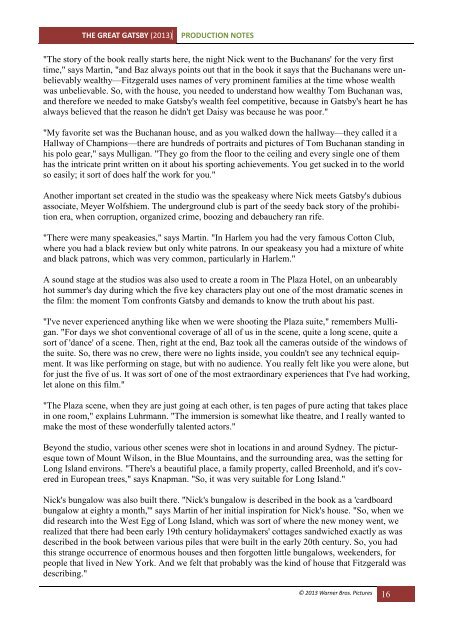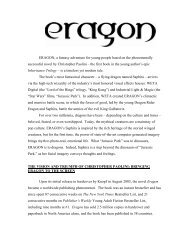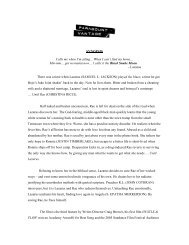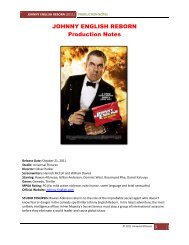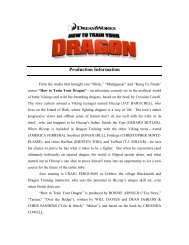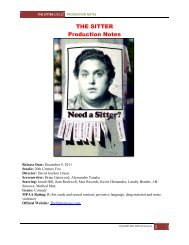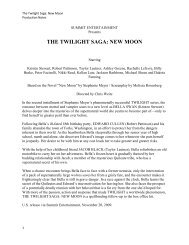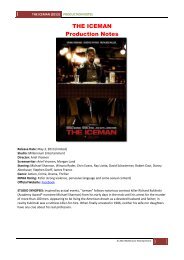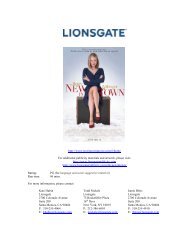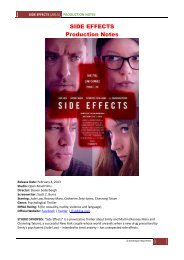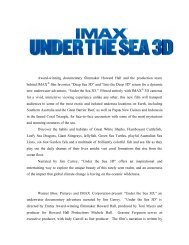THE GREAT GATSBY Production Notes - Visual Hollywood
THE GREAT GATSBY Production Notes - Visual Hollywood
THE GREAT GATSBY Production Notes - Visual Hollywood
You also want an ePaper? Increase the reach of your titles
YUMPU automatically turns print PDFs into web optimized ePapers that Google loves.
<strong>THE</strong> <strong>GREAT</strong> <strong>GATSBY</strong> (2013)<br />
PRODUCTION NOTES<br />
"The story of the book really starts here, the night Nick went to the Buchanans' for the very first<br />
time," says Martin, "and Baz always points out that in the book it says that the Buchanans were unbelievably<br />
wealthy—Fitzgerald uses names of very prominent families at the time whose wealth<br />
was unbelievable. So, with the house, you needed to understand how wealthy Tom Buchanan was,<br />
and therefore we needed to make Gatsby's wealth feel competitive, because in Gatsby's heart he has<br />
always believed that the reason he didn't get Daisy was because he was poor."<br />
"My favorite set was the Buchanan house, and as you walked down the hallway—they called it a<br />
Hallway of Champions—there are hundreds of portraits and pictures of Tom Buchanan standing in<br />
his polo gear," says Mulligan. "They go from the floor to the ceiling and every single one of them<br />
has the intricate print written on it about his sporting achievements. You get sucked in to the world<br />
so easily; it sort of does half the work for you."<br />
Another important set created in the studio was the speakeasy where Nick meets Gatsby's dubious<br />
associate, Meyer Wolfshiem. The underground club is part of the seedy back story of the prohibition<br />
era, when corruption, organized crime, boozing and debauchery ran rife.<br />
"There were many speakeasies," says Martin. "In Harlem you had the very famous Cotton Club,<br />
where you had a black review but only white patrons. In our speakeasy you had a mixture of white<br />
and black patrons, which was very common, particularly in Harlem."<br />
A sound stage at the studios was also used to create a room in The Plaza Hotel, on an unbearably<br />
hot summer's day during which the five key characters play out one of the most dramatic scenes in<br />
the film: the moment Tom confronts Gatsby and demands to know the truth about his past.<br />
"I've never experienced anything like when we were shooting the Plaza suite," remembers Mulligan.<br />
"For days we shot conventional coverage of all of us in the scene, quite a long scene, quite a<br />
sort of 'dance' of a scene. Then, right at the end, Baz took all the cameras outside of the windows of<br />
the suite. So, there was no crew, there were no lights inside, you couldn't see any technical equipment.<br />
It was like performing on stage, but with no audience. You really felt like you were alone, but<br />
for just the five of us. It was sort of one of the most extraordinary experiences that I've had working,<br />
let alone on this film."<br />
"The Plaza scene, when they are just going at each other, is ten pages of pure acting that takes place<br />
in one room," explains Luhrmann. "The immersion is somewhat like theatre, and I really wanted to<br />
make the most of these wonderfully talented actors."<br />
Beyond the studio, various other scenes were shot in locations in and around Sydney. The picturesque<br />
town of Mount Wilson, in the Blue Mountains, and the surrounding area, was the setting for<br />
Long Island environs. "There's a beautiful place, a family property, called Breenhold, and it's covered<br />
in European trees," says Knapman. "So, it was very suitable for Long Island."<br />
Nick's bungalow was also built there. "Nick's bungalow is described in the book as a 'cardboard<br />
bungalow at eighty a month,'" says Martin of her initial inspiration for Nick's house. "So, when we<br />
did research into the West Egg of Long Island, which was sort of where the new money went, we<br />
realized that there had been early 19th century holidaymakers' cottages sandwiched exactly as was<br />
described in the book between various piles that were built in the early 20th century. So, you had<br />
this strange occurrence of enormous houses and then forgotten little bungalows, weekenders, for<br />
people that lived in New York. And we felt that probably was the kind of house that Fitzgerald was<br />
describing."<br />
© 2013 Warner Bros. Pictures<br />
16


